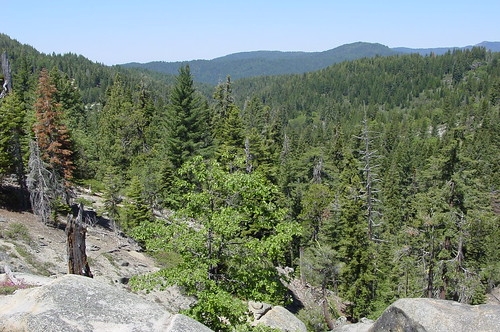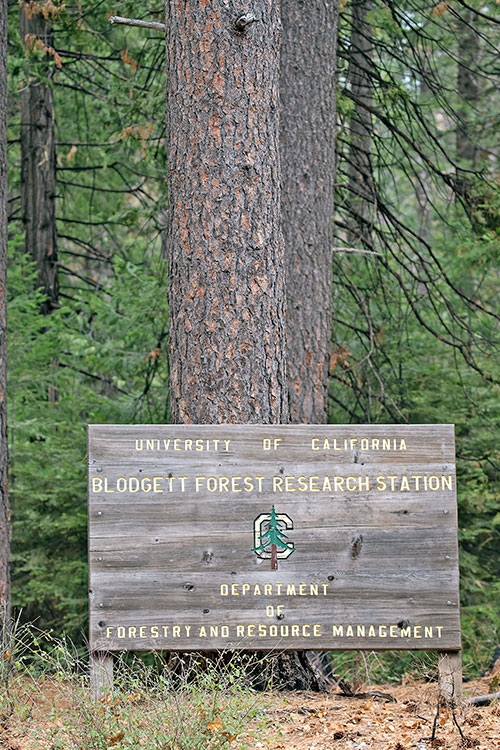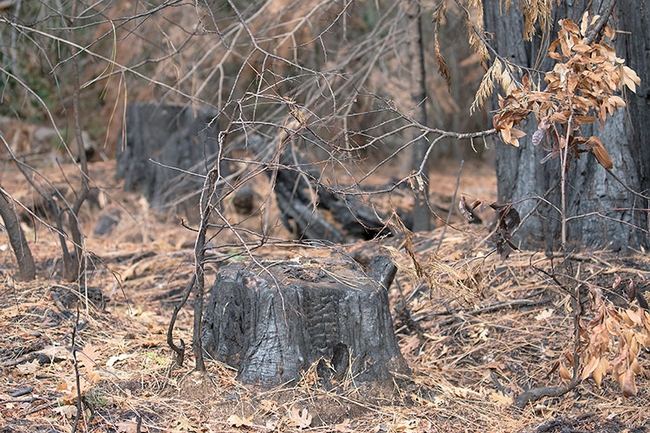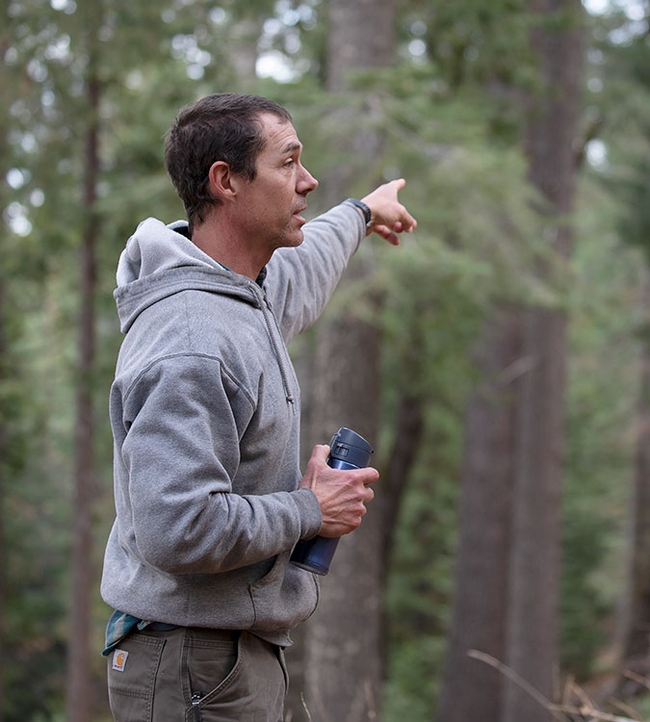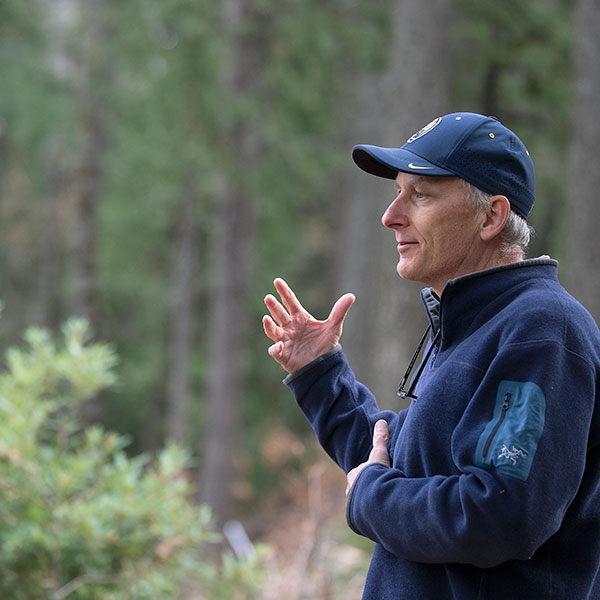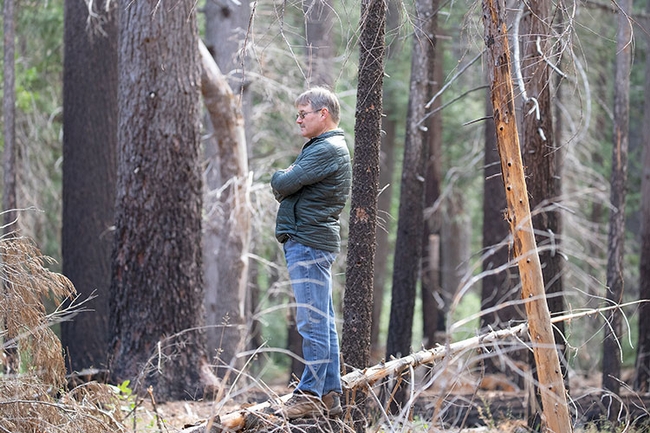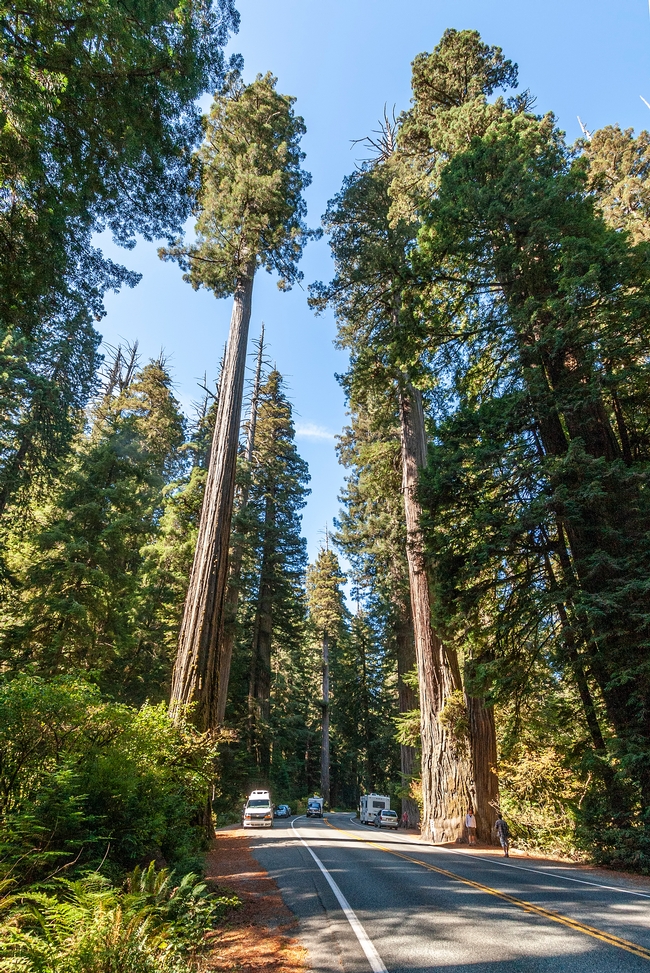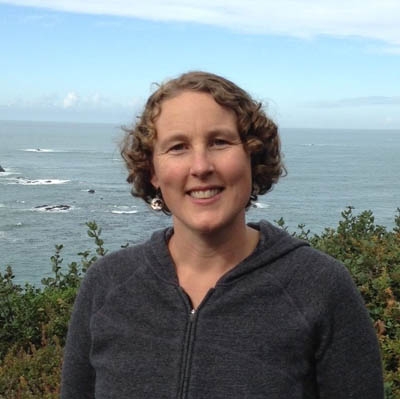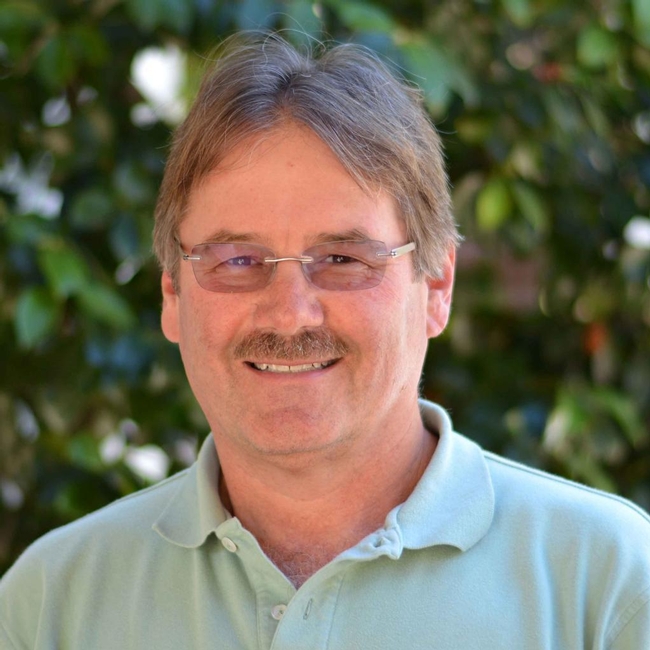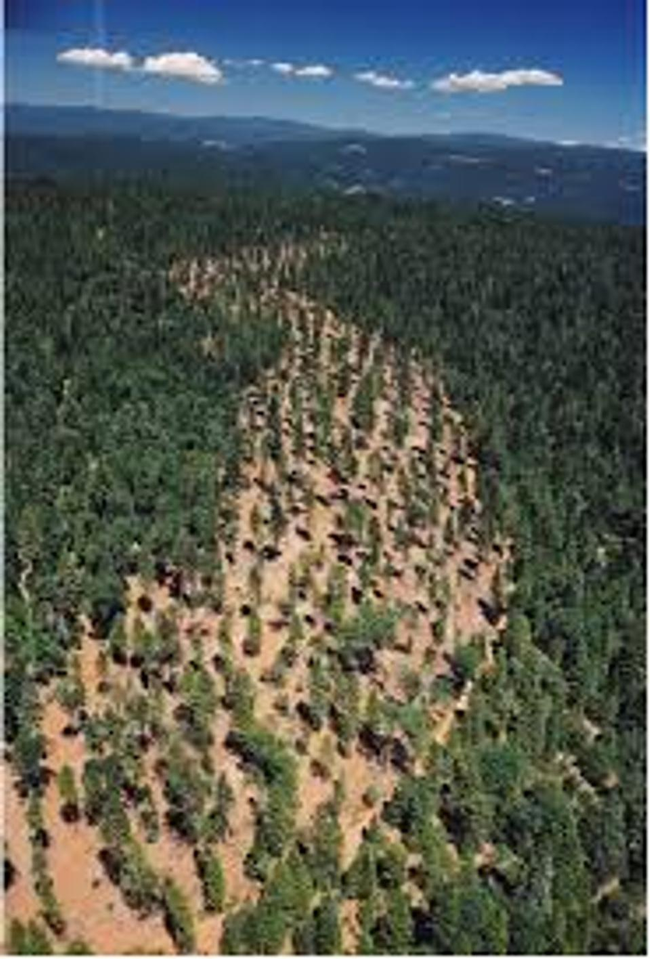Posts Tagged: Scott Stephens
Previous tree mortality and density big factors in the devastating 2020 Creek Fire
Wildfires burning in western U.S. forests have increased in size and severity since the late 20th century, with a number of recent fires exhibiting characteristics that match the criteria for mass fires – or fires that burn with high intensity over large continuous areas for long durations of time.
Operational fire behavior models, commonly used by federal and state fire suppression agencies to predict how wildfires will behave, cannot predict mass fire behavior, largely because they do not include the important combustion and fire-atmosphere interactions. The Creek Fire, which exhibited mass fire behavior when it burned through the southern Sierra Nevada in 2020, was analyzed to better understand the mechanisms and forest conditions that contribute to devastating wildfires.
Scott Stephens, Alexis Bernal and Brandon Collins in the Department of Environmental Science, Policy and Management at University of California, Berkeley, along with other colleagues used both ground-based and remotely sensed data to analyze behavior patterns of the 2020 Creek Fire to determine which variables were important in predicting fire severity.
Findings indicated that dead biomass and live tree density were the two most important variables – more so than treatment history (i.e. timber harvesting, fire hazard reduction treatments, etc.), fire history or topography. Areas with the highest amounts of dead biomass and live tree densities were also positively related to high-severity fire patch size — indicating that large homogenous swaths of these types of conditions resulted in adverse, landscape-scale fire effects.
“Forest restoration must be increased greatly in California forests, the Creek Fire shows us what will happen if we don't move decisively ” said Stephens, lead author on the work, which is published in a new paper in the journal Forest Ecology and Management.
Additional analysis revealed that although the first two days of the Creek Fire were abnormally hot and dry, weather during the days of the greatest fire growth was largely within the normal range for the time of year (late summer). The spatial distribution of fire intensity during those days, however, revealed some notable patterns, with the concentration of heat from the fire being in the opposite location of where it would be expected. Specifically, on the day of the largest fire growth (Sept. 6), not only was the greatest heat concentrated away from the fire perimeter (or “flaming front,” which is the expected location for heat concentration), but a significant amount of heat was still being generated within the previous day's fire perimeter. This finding is critical to better understanding how traditional fire behavior models may or may not accurately predict fire behavior in forests that have large, contiguous areas of dead trees and high live tree density – an increasingly common forest fuel condition in Sierra Nevada forests.
The findings of this study have important implications for forest managers, as they indicate that in certain forest structures (i.e. those with large, homogenous swaths of dead biomass or high densities of live trees) conventional fire models may dramatically underpredict the spread rate and area burned because these models do not correctly capture the physics driving the fire.
The Creek Fire is one of a number of fires that shows how vulnerable forests are to current frequent-fire forest conditions, suffering high tree mortality and offering fuel conditions capable of generating mass fires from which future forest recovery is questionable because of type conversion and probable reoccurring high severity fire.
The study, titled “Mass Fire Behavior Created by Extensive Tree Mortality and High Density Not Predicted by Operational Fire Behavior Models in the Southern Sierra Nevada,” was published online on May 16 in the journal Forest Ecology and Management.
The authors of the paper are:
- Scott Stephens, Department of Environmental Science, Policy and Management, University of California, Berkeley.
- Alexis Bernal, Department of Environmental Science, Policy and Management, University of California, Berkeley.
- Brandon Collins, Department of Environmental Science, Policy and Management and Center for Fire Research and Outreach, University of California, Berkeley.
- Mark Finney, USDA Forest Service, Rocky Mountain Research Station.
- Chris Lautenberger, Reax Engineering.
Lessons on wildfire resilience from a 4,000-acre forest lab
In his years managing California woodlands, Rob York has come up with a few quick and easy ways to gauge whether a forest is prepared for wildfire.
“The first question I like to ask is, ‘Can you run through the forest?'” York says.
York, an assistant cooperative extension specialist and adjunct associate professor of forestry at UC Berkeley, poses the question while standing in a grove of pine trees during a tour of Blodgett Forest Research Station, a 4,000-acre experimental forest in the northern Sierra Nevada. While fire suppression has allowed many of California's forests to grow thick and dense, this patch of forest is one you could actually run through: The area is punctuated by large trees spaced a few meters apart, separated by a smooth carpet of dried pine needles.
“The idea is, if it doesn't have a lot of buildup of surface fuel on the ground — sticks and logs — you should be able to run through it,” York adds. “Looking through this forest, I might have to jump over that log, but, generally, I could take a jog through it.”
For more than 50 years, York and other Berkeley forestry researchers have used Blodgett as a living laboratory to study how different land management treatments — including prescribed burning, restoration thinning and timber harvesting — can reduce the risk of severe wildfire and improve a forest's resilience to the impacts of climate change. In addition to research, Blodgett regularly hosts workshops to demonstrate different land management techniques to landowners.
After another year of record-breaking wildfires in California, the work at Blodgett is more critical than ever, and state and federal agencies are motivated to enact more effective forest management practices. In 2020, the state and the U.S. National Forest Service jointly committed to managing 1 million acres of California forests a year, and last month the Biden administration pledged billions in new federal funding to reduce wildfire risk in the state.
“[Blodgett] was really designed to eventually demonstrate land management alternatives and offer a glimpse into how they might look at bigger scales,” York said.
Experimenting with fire
Blodgett Forest is “pretty representative of millions of acres of Sierra mixed conifer forest,” said Ariel Roughton, a research stations manager at Berkeley Forests. After the majority of its trees were logged in the early 1900s, the forest was donated to Berkeley in the 1930s with the intent that it would be used to study sustainable timber production. Aside from a few old relics that survived early logging, the majority of the trees are regrowth and approximately 100 years old.
“Back then, people thought, ‘Why would you ever want to use fire for land management?' They wanted to grow trees, they want to grow timber. The idea of seeing black and char was literally off the scale,” said Scott Stephens, a professor of forest science and co-director of Berkeley Forests. “It's amazing that just a few decades ago, researchers didn't have the opportunity to do the work that Rob and Ariel and others are doing up here now.”
In the open, airy tract of forest that York could easily jog through, blackened scorch marks extend 10 to 15 feet up the trunk of each tree. Ecologists believe that before European colonization, these forests experienced fire once every 10 years or less, leading to open forest structures very similar to this one. Here, two years ago, Roughton, York and their colleagues conducted a prescribed burn to remove excess fuel from the ground and reduce the risk of wildfire.
“I think it's important to remember that nature hasn't taken its course without a lot of human intervention since the last glaciation, because there was strong Indigenous burning here,” said John Battles, a professor of forest ecology at Berkeley. “There has always been intense human stewardship of one sort or another.”
According to the researchers, it took 15 to 20 years of active management, followed by regular maintenance, to get the forest tract to this state. Over the years, they have worked to achieve the open forest structure by harvesting some of the bigger trees for timber, but leaving the largest behind. They have also used a machine called a masticator to chip up smaller trees and conducted regular prescribed burns.
While there are forest management strategies that can be effective on a shorter time scale, it usually takes at least a few separate treatments over the course of a few years to successfully restore a forest and reduce its wildfire risk, York explains.
“It can be a challenge to get to the forest structure that we want,” York says. “It takes a lot of time, and it takes a lot of investment.”
Climate change is also narrowing the annual windows of time when conditions are best for prescribed burning, limiting when and how often foresters can safely burn. Hot, dry conditions usually make prescribed burning too risky during the summer, while rain and snow in the winter can leave the forest too wet and damp for fire to burn. However, research at Blodgett is showing that, with the right management decisions, prescribed burning during the winter can be made more viable.
“Because of timber harvests that removed some of the canopy and subsequent treatments to remove the ladder fuel, we now have more light hitting the ground, and it dries out faster,” Roughton said. “We've gotten to the point out here where we're able to burn more easily because of our past management actions.”
Friends of the forest
While York likes to imagine running through the trees, Battles has a slightly different metric for evaluating the health of a forest.
“You need to be able to run through the woods,” Battles said. “But I also want to see all six of my friends as I do my run.”
Battles' friends are the six tree species that make up the Sierra mixed conifer forest: oak, ponderosa pine, sugar pine, white fir, Douglas fir and incense cedar. Fire suppression — and the dense, overgrown forest structures that can result — often favor the survival of some of these species over others, leading to forests that are dominated by just one or two species. This lack of biodiversity can make the forest, as a whole, less resilient to stressors like bark beetles or tree pathogens, which often target some of these species, but not others.
According to Battles, the open structure and frequent fire at this tract of Blodgett has allowed all six of his friends to flourish.
“I see my friend, ponderosa pine, which you don't see as frequently in the unburned forest because it's shade intolerant — it needs light. I see oak, and it also requires fire to get a lot of the oaks,” Battles said. “I see all six of my friends all here, and you only see them when you have management like this.”
Over the past 20 years, research has shown that prescribed burning and mechanical thinning with tools like the masticator can also benefit soil quality and water availability, while having no significantly negative impacts on forest ecosystems. While burning or otherwise removing plants and trees can release carbon dioxide into the atmosphere, which accelerates the impacts of climate change, reducing the risk of severe wildfire can help maintain the whole forest for long-term carbon storage.
However, applying these techniques across 33 million acres of California forestland remains a monumental task. Prescribed burning requires a great deal of expertise and is also limited by weather conditions and air quality regulations. Meanwhile, mechanical tree thinning can be costly, and unlike timber harvesting, it does not generate any revenue for landowners — though Berkeley researchers have suggested that creating a market for small trees and other woody biomass could help offset the cost while limiting carbon emissions.
“Fire used to be so common in this system, and that's no different than in most forests in California. But, when you take it out for that long, you begin this transformation,” Stephens said. “That's why we have to get both public and private entities together to come up with a philosophy to be able to move forward on this. Blodgett is 4,000 acres — that's interesting, but it doesn't really address the needs of the state. We always hope that our work shows people what's possible and then enables them to continue it.”
Forest management can help giant sequoias and coastal redwoods survive
In 2020, 9,000 fires scorched more than 4 million acres of California, a record-breaking year, reported Alejandra Borunda in National Geographic. Fires burned through homes and oak forests, grasslands and pines — and also through patches of giant sequoias and coast redwoods, respectively the most massive and the tallest trees on earth.
Giant sequoias are not the oldest living trees, but some have been growing in Sierra Nevada forests for more than 3,200 years. They are found in 68 groves on the Sierra's western flank. The state's redwood forests grow in a narrow strip along the coast of Northern California and Southern Oregon.
The 2020 fires burned through about 16,000 acres of sequoia groves, about a third of their total area. In redwood forests of the Santa Cruz Mountains, 40,000 acres burned.
But because redwoods are well-adapted to fire, they'll likely recover pretty quickly, said Scott Stephens, a UC Berkeley fire scientist. “In some ways, this fire could make redwoods more dominant in the landscape," he said, because other trees — like the hardwoods or Douglas firs that crowded the local forests — died outright in the burns.
However, scientists are concerned one cause of the fires, climate change, could have additional impacts on these natural treasures.
Since the mid-1800s, temperatures in the western U.S. have increased by 1.6 degrees Fahrenheit. Fog banks are fading in coast redwood territory, and snows are less consistent in the Sierras. The changes leave redwoods and sequoias without their preferred climate conditions.
The most responsible thing to do now, Stephens said, is to “take the opportunity that has been handed to us,” and make a plan to go back in and burn again—soon, within the next few years.
UC Cooperative Extension forestry advisor Lenya Quinn-Davidson agrees that California must manage fire to help the trees survive. Tree-ring records show that humans have influenced the fire regime for better and worse as long as they've been in these forests.
“The empowering message there is, human management can actually override the effects of climate in a fire contest,” Quinn-Davidson said. “It's not just a climate story. We can't just throw in the towel, feel overwhelmed, and tell ourselves these trees are done for. That's not true!”
North Coast forests are more dense and dry, fueling fires
Five of California's six largest fires have occurred in 2020, reported Julie Cart in CalMatters.
“There is a collective sensation that we are reaching a tipping point,” said Lenya Quinn-Davidson, a fire specialist with the University of California Cooperative Extension. “This year was not just the fluke burning horrifically. This is 3.2 million acres of fire that burned in a month.”
Quinn-Davidson is based in Humboldt County, with typically rainy, foggy redwood forests. However, she said, the forests don't resemble their former state.
"They are suffering from the same things that the rest of the state forests are. They are poorly managed and have fuels buildup," Quinn-Davidson said.
Redwood and pine forests are many times more dense than at any time in their history.
"We are now entering a new regime, the climate is changing and we are seeing drier conditions and we are seeing a longer fire season. We are not getting that fall precipitation," she said.
The state's 2018 Fourth Climate Assessment included dire predictions for the North Coast: “Future wildfire projections suggest a longer fire season, an increase in wildfire frequency, and an expansion of the area susceptible to fire.”
Average annual maximum temperatures in Mendocino, Humboldt, Del Norte, Lake, Trinity and Siskiyou Counties could increase by as much as 9 degrees through the end of the century, the report concluded.
“The weather and climate is impacting these areas. Last year we were at 60% of average precipitation. We're drier than normal,” said Scott Stephens, a fire scientist at UC Berkeley. “So when lighting strikes, you get an overwhelming number of ignitions in fuels that have been preconditioned to burn.”
The fog that reliably blankets the North Coast is dissipating. Research from UC Berkeley found that fog frequency has declined by a third compared with a century ago.
“Even here in Humboldt County — we are right on the ocean, basically in a rainforest — people are starting to look around and say, ‘Is my house ready for a wildfire?' I'm hearing those conversations,” Quinn-Davidson said.
UC ANR experts suggest ways to ease California's fire crisis
Three news articles over the last weekend shared comments from UC Agriculture and Natural Resource's experts about forest management practices that can help reduced the catastrophic wildfires being experiences in the West.
Prescribed burns and management change fire behavior
Shaver Lake forest historian Jared Dahl Aldern tweeted that, when the high-intensity Creek Fire arrived at the Shaver Lake forestlands, it turned into a low-intensity “surface fire,” which does not threaten the bigger and older trees. “The fire comes up to @SCE land,” tweeted Aldern, “drops to the ground, and stays out of the tree crowns.”
Whatever happens to Shaver Lake, says University of California Cooperative Extension specialist Rob York, “There are lots of cases in the scientific literature of prescribed burns having changed fire behavior.”
The image below shows a “shaded fuel break,” consisting of selectively-thinned forest surrounded on both sides by dense forest. “The strip of forest may change fire behavior in the treated area,” said York, “but not on either side.
Forbes, Sept. 13, 2010
Michael Shellenberger
Millions of dead trees fueling unprecedented firestorms in the Sierra Nevada
“I don't want to be alarmist. But I think the conditions are there,” said Scott Stephens, a UC Berkeley professor of fire science and lead author of a 2018 paper that raised the specter of future mass forest fires as intense as the Dresden, Germany, and Tokyo firebombings.
“As those [trees] continue to fall, the physics of it are unchanged. If you have dead and downed logs … the fires described in warfare are possible.”
A combination of prescribed fire, restoration thinning and making rural communities more fire resistant are needed, Stephens said.
“If we don't come out of this year focused on that and try to move forward, I just don't know if there's much hope,” he said. “I'm always hopeful. But I'm getting tired.”
Los Angeles Times, Sept. 13, 2020
Bettina Boxall
Results of long-time fire suppression
Perhaps the most present term in news articles as one of the main causes for fires getting so big so fast is fire suppression, which has resulted in a lack of fire for more than a century.
In the 1920s, this idea of suppressing wildfires grew even more when the Forest Service decided intentional burning was a bad idea. In 1924 a Siskiyou National Forest Supervisor said the ‘“Brushy Hell' of shrublands must be protected for the benefit of future timberland succession, ‘so leave them alone.'”
“The Forest Service said it ruins forests, it was bad forest management,” said Kocher. “Then in 1924, California followed suit and said it was not legal to burn forests on purpose.”
Kocher says this idea of letting trees grow and not letting forests burn naturally every decade wasn't this malicious idea either.
“They would have thought, ‘Oh, we're doing this great work where we're leaving all these extra trees for people to use for timber moving forward,'” she said. “I don't think those early foresters ever could have foreseen how fire could get away from them.”
Capitol Public Radio, Sept. 12, 2020
Ezra David Romero


